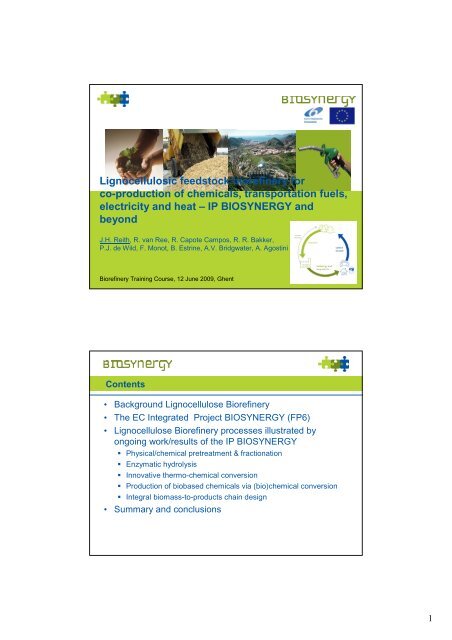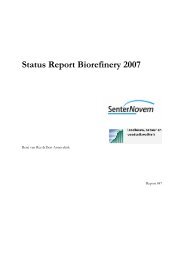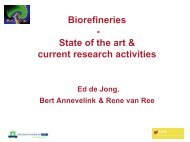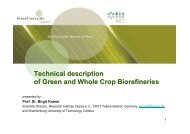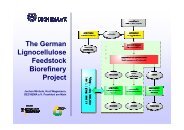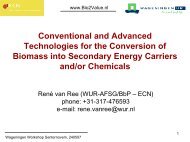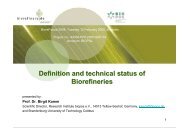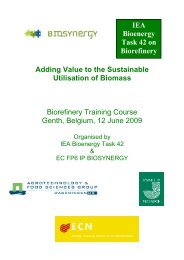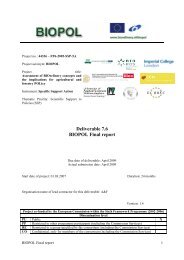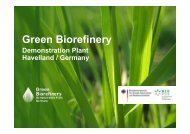Lignocellulosic Feedstock Biorefinery - Reith.pdf
Lignocellulosic Feedstock Biorefinery - Reith.pdf
Lignocellulosic Feedstock Biorefinery - Reith.pdf
Create successful ePaper yourself
Turn your PDF publications into a flip-book with our unique Google optimized e-Paper software.
<strong>Lignocellulosic</strong> feedstock biorefinery forco-production of chemicals, transportation fuels,electricity and heat – IP BIOSYNERGY andbeyondJ.H. <strong>Reith</strong>, R. van Ree, R. Capote Campos, R. R. Bakker,P.J. de Wild, F. Monot, B. Estrine, A.V. Bridgwater, A. Agostini<strong>Biorefinery</strong> Training Course, 12 June 2009, GhentContents• Background Lignocellulose <strong>Biorefinery</strong>• The EC Integrated Project BIOSYNERGY (FP6)• Lignocellulose <strong>Biorefinery</strong> processes illustrated byongoing work/results of the IP BIOSYNERGY Physical/chemical pretreatment & fractionation Enzymatic hydrolysis Innovative thermo-chemical conversion Production of biobased chemicals via (bio)chemical conversion Integral biomass-to-products chain design• Summary and conclusions1
Lignocellulose as feedstock• Low-cost feedstock (~50-60 € / ton d.w.; 3-4 € /GJ) e.g straw, woodresidues, energy crops,..• Alternative source of sugars (to replace starch, sugar agro feedstocks)• High availability / Limited competition with food production• High CO2 reduction for 2-G biofuels and biobased productsAvailability of lignocellulose in the EU-271) wood & wood based residues2) agricultural residues of food and feed crops (straw, stover,..)>10 Mt>1 Mt & 5 Mt & 1 Mt &
<strong>Lignocellulosic</strong> biomassComplex raw material due to complex structure of the plant cell wall: intermeshedcarbohydrate and lignin polymers.Cellulose= linear, highly crystalline glucose polymerHemicellulose:branched co-polymerof C5 (Xyl, Ara) andC6 sugars (Glc, Man,Gal)Large variety in composition and structure esp.hemicellulose and lignin fractionsPolymers have differential reactivity to thermal,chemical and bioprocessingLignin:random copolymeroffenylpropaneunits:matrix or‘glue<strong>Lignocellulosic</strong> <strong>Feedstock</strong> <strong>Biorefinery</strong>• Abundant low-cost feedstock: wood,straw, corn stover, cellulose containingresidues and waste• Multiple products : transportationfuels, chemicals, polymers, materialselectricity and heatSource: Kamm et al., Wiley-VCH, 2006• Physical-chemical pre-treatment & fractionation of lignocellulose• Enzymatic hydrolysis of (hemi)cellulose• Fermentation / chemical conversion of intermediates• System integration CHP from process residues Heat integration, water recycle3
Potential products Lignocellulose <strong>Biorefinery</strong>Products generated via• (Thermo)chemicalconversion• Bioprocessing• Natural monomerstructure largelypreserved• Products have a goodposition in the current(petrochemical) marketand future biobasedmarket (building blocks):•Furfural•HMF•Fermentation productsIntegrated Project BIOSYNERGYBIOmass for the market competitive and environmentally friendlySYNthesis of bio-products – chemicals and/or materials – togetherwith the production of secondary enERGY carriers – transportationfuels, power and/or CHP – through the biorefinery approach.● Development of integral LC cellulose-ethanol based <strong>Biorefinery</strong>● Focus on valorisation of residues from cellulose ethanol production to makethe production of this biofuel more cost competitive● Bioprocessing and thermochemical pathways combined● Process development from lab-scale to demonstration at pilot-scale.17 partners from industry, R&D institutes and Universities from10 EU countriesEU FP6 Program: Contract No. 038994 – SES 6. EC Officer: Silvia Ferratini.Duration: 1-1-2007 – 31-12-2010 (48 months)Budget: 13.4 M€, EC grant 7M€4
Product lines in the IP BIOSYNERGYMulti-product biorefinery, Focus on residues cellulose ethanol i.e. C5 and lignin valorisation<strong>Lignocellulosic</strong>biomassEsp.STRAWPhysicalchemicalpretreatment&FractionationCelluloseHemicelluloseEnzymaticHydrolysisC6 sugarsC5 sugarsFermentationChemicalConversionEthanolABEXylonic acid(HMF) > 2,5 FDAFurfuralPentosideSurfactantsLigninSCDepolymerisationCatalyticPyrolysisChemicalconversionEnzymaticconversionFractionationPhenolicsActivatedligninsResins /ThermosetsB i o m a s s r e s i d u e sCHPHeat & Powerto processPhysical-chemical pretreatment & fractionationGoals:● Controlled fractionation of lignocelluloseinto fractions with sufficient quality forproduction of (bio)chemicals● enhance access cellulose for enzymatichydrolysis to sugar monomers in highyield /low enzyme use●Minimize by-product formation and theuse of chemicals, water, energy and costs● Preferably lignin as high purity byproductavailableMosier N, Wyman C, Dale B, Elander R, Lee YY,Holtzapple M, Ladisch MR, 2004. Features ofpromising technologies for pretreatment oflignocellulosic biomass. Bioresource Technology,Volume 96, Issue 6, April 2005, Pages 673-6865
Physical-chemical pretreatment & fractionation• Challenge: Biomass recalcitrance caused by Complex structure of the plant cell wall high crystallinity of cellulose• Several routes under development: Steam pre-treatment Mild-acid/thermal pre-treatment Mild alkaline pretreatment Organosolv Ammonia Fiber Explosion (AFEX)• No cost-effective industrial pre-treatment technology available yet• Most processes suffer from major drawbacks: formation of inhibitors,high use energy or chemicals, waste production, high cost etc.• Most routes produce low quality lignin residueEnzymatic cellulose hydrolysis3 types of enzyme activity requiredSource: Kevin A. Gray Ph. D. , 2007. Conversion of lignocellulosic biomass into liquid transportation fuels DiversaCorporation/Celunol, San Diego, CA , USA. http://www.epobio.net/workshop0705/presentations/KevinGray.<strong>pdf</strong>6
Enzymatic hemicellulose hydrolysisSource: Kevin A. Gray Ph. D. , 2007.Conversion of lignocellulosic biomassinto liquid transportation fuels DiversaCorporation/Celunol, San Diego, CA ,USA.http://www.epobio.net/workshop0705/presentations/KevinGray.<strong>pdf</strong>• More structural complexity than cellulose• Variable composition per biomass source• Tailor made combination of enzyme activities requiredStatus enzymatic (hemi)cellulose hydrolysis• Specific enzyme cocktails/activities required per feedstock type• 20-30 fold cost reduction cellulases claimed by enzyme manufacturersNovozymes, Genencor. For on-site enzyme production.• Enzyme cost no longer the major cost driver cellulose ethanol: fromapprox. 45% to > Enzymes required toreduce in-process feedstock viscosityPhoto: Enzymatic hydrolysis ofpretreated wheat straw (12 wt%)WURAFSG, EET project K01116• Enzyme development must be tailored to feedstock AND pretreatmentas well as to fermentation. Further cost reduction required.7
WP1: Advanced physical/chemical fractionation• Model feedstocks: straw, woodsProcesses studied• Mechanical/Alkaline fractionation (A&F)*• Ethanol/water Organosolv (ECN)*• Organic acid organosolv (Avidell process; ARD)• Acid hydrolysis (<strong>Biorefinery</strong>.de)• Reference technology: steam explosion (ABNT)• Enzymatic cellulose hydrolysisEthanol/H2O Organosolv, ECN Mech./alk pretreatment A& Acid organosolv Pilot plant ARDPartners: A&F, ABNT, ARD, Bioref, ECN, TUDPreliminary conclusions pretreatment/fractionation• No clear “winner”: All studied routes lead to significant fractionation ofC5, C6 sugars and lignin from lignocellulose• Differences in cellulose hydrolysis yieldsDigestibility of cellulose by enzymatic hydrolysis100%90%92%• Processes need to be optimised toward a particular goal, for example:Hemicellulose hydrolysis for further processing of C5High enzymatic degradability of the cellulose fractionRecovery of a high quality lignin stream• Benchmarking/Economic evaluation in progressyield of hydrolysis80%70%60%50%40%30%20%10%0%Pretreated Barley Straw APretreated Barley Straw C0 10 20 30 40 50 60 70 80 90 100hours60%57%48%Pretreated Wheat Straw BPretreated Wheat Straw DLignin products from Modified Organosolv Fractionation (ECN)8
WP2: Innovative thermo-chemical conversionTopics• Staged (catalytic) thermochemicalprocessing of biomass and lignin (ECN,Aston)• Catalytic fast pyrolysis (BTG, Aston)• Integrated development of separation/upgrading technologyPartners: ECN, Aston, BTGBFB reactor ECNThermochemical production of chemicals from woodLignin: amorphous copolymer of phenyl-propeneunits; formed via a random radical copolymerisationof: (1) coumaryl alcohol, (2) coniferyl alcohol, (3)sinapyl alcoholHemicellulose:amorphous polymer ofxylose (C5-sugar), C6sugars and a variety ofside-chainsCellulose: polymer ofglucose (C6-sugar) withboth crystalline andamorphous regions9
Staged thermochemical processingOpportunities• Sequential thermal decompositionhemicellulose > cellulose > lignin• Condensable products: C2-C4, acids,furans, anhydrosugars, phenolics (+char and syngas)Challenges• Optimisation of individual product orproduct group yields via catalysis,process conditions: temperature, heatingrate, vapour and solid residence times• Product separation and upgrading100 °CMoistureDrying200 °CExtractivesTorrefaction forenhanced wood fuelsHemicellulose300 °CAcids, furansCellulose400 °CAnhydrosugars,HMFhemicellulose cellulose ligninUse of catalystsTorrefaction Pyrolysis GasificationBiomass 180 - 290°C 290 - 600°C > 600°C BioSyngascatalyst ? catalyst ? catalyst ?Crude Crude CrudeProduct separation and upgrading500 °CPhenolsmethanolFlash pyrolysis for bio-oil600 °Ccharcoal100 °C 200 °C 300 °C 400 °C 500 °C 600 °CLigninCarbonisationfor charcoalchemicalsfuelspowerheatBase/platform Lignin chemicalsBio-cascade for drying, torrefaction and pyrolysisComparison thermochemical processing strawYield (wt% d.b.)DIRECT THERMOCHEMICAL PROCESSING AT 350°CBubbling fluidised bed pyrolysis1086Yield (wt% d.b.)STAGE 2 THERMOCHEMICAL PROCESSING AT 310°CAuger reactor degasification of the residu from stage 11086Yield (wt% d.b.)STAGE 2 HYBRID THERMOCHEMICAL PROCESSING AT 350°CBubbling fluidised bed pyrolysis of the residu from stage 11086444222000MethanolFormic acidAcetic acidHydroxyacetaldehydeAcetolFurfuralHMFPhenolsLevoglucosanMethanolFormic acidAcetic acidHydroxyacetaldehydeAcetolFurfuralHMFPhenolsLevoglucosanMethanolFormic acidAcetic acidHydroxyacetaldehydeAcetolFurfuralHMFPhenolsLevoglucosanYield (wt% d.b.)STAGE 1 THERMOCHEMICAL PROCESSING 1 AT 260°CAuger reactor degasification1086Yield (wt% d.b.)STAGE 1 HYBRID THERMOCHEMICAL PROCESSING AT 200°CAquathermolysis in an autoclave108644220MethanolFormic acidAcetic acidHydroxyacetaldehydeAcetolHybrid thermochemicalOne-step BFB pyrolysis Staged (de)gasification processingSelected chemicals from wheat straw via 1-step BFB pyrolysis, via staged degasification inan auger reactor and via hybrid thermochemical processing involving aquathermolysis andBFB pyrolysis showing the superior performance of the hybrid conceptP.J. de Wild et al, “ Biomass valorisation by a hybrid thermochemical fractionation approach”; submitted to InternationalJournal of Chemical reactor Engineering, 2009FurfuralHMFPhenolsLevoglucosan0MethanolFormic acidAcetic acidHydroxyacetaldehydeAcetolFurfuralHMFPhenolsLevoglucosan10
Separation/upgrading thermochemical produced bio-oils• Staged condensation for separation of (groups) of chemicals• Procedures to improve quality of pyrolysis oil (filtration, dewatering)• Separation technology is a vital issue80-250 kg/hr rotating cone fastpyrolysis pilot plant at BTGLignin valorizationsyringyl-unit• Lignin contains numerous valuable aromatic (phenolic) structures• Valorisation to products (even partial) improves carbon footprint andrevenue of the biorefineryguaiacyl-unit• Most internal lignin bonds viathe para position• Approx. 50% of all bonds areof the β-O-4 typeTechnologies• Combustion for heat and/or power• Gasification for syngas• Hydroliquefaction for transportation fuels (reformulated gasoline)• Direct application ‘organosolv’ lignins• Pyrolysis for production of chemicals (monomeric phenols) and/orperformance productsSuccessful valorisation of lignin is a key-issue foran economically viable lignocellulosic biorefinery.11
Potential applications of lignin-derived phenolics’Green’ plasticsWood-adhesives and resins• Fuel additives (aromaticethers)• BTX• Binders• Carbon Fiber (for CFcomposites)• epoxies• polyolefinsSpecialty phenolics for highvalueapplications such asfragrances and pharmaceuticalsLignin thermal conversion via pyrolysis: complexPermanent gases & water(CO, CO 2, CH 4, H 2O)degradationLigninMeltingPyrolysisMonomeric phenolsCatalystCondensation / degradationOligomeric phenolsCondensationChar•For a maximal conversion of lignin into (monomeric) phenols there is a narrow window ofpyrolysis conditions such as temperature, heating rate, vapour and solid residence time.•First of all a proper feeding procedure is required to overcome lignin’s thermoplastic behaviourthat causes severe operational problems such as screw feeder clogging by molten lignin,agglomeration and subsequent defluidisation of the reactor bed.•Use of catalyst to improve product selectivity and yield12
Improving feeding behaviour: constructionof a water-cooled screw feeder• Hollow screw designRecent work Paul de Wild c.s.ECNNitrogenBubblingfluidised bedreactorCycloneVentFreeboardScrew operatedfeed bunkerCooled feeding screwBubblingfluidisedhot sandbedCyclone ashcollection binProduct gas samplingHeated soxhletparticle filterArgon fluidisation gasHeaterCoolantESPBubbling fluidisedbed pyrolysis test rigPyrolysis productobtention test rigPump13
Improving thermal processing by application of a catalystProduct yield in wt% dry feedstock54321Bubbling fluidised bed fast pyrolysisof herbaceous lignin at 400°C - 500°CCatalytic pyrolysisNon-catalytic pyrolysis0Methanol Guaiacols Syringols Phenols CatecholsContinuous catalytic pyrolysis results• 100 lignin pyrolyse to:17 - 20 gas (CO, CO 2 , CH 4 )20 - 25 water13 - 20 organiccondensables• 30 - 35 solid (char)• The liquid product has beencollected in two fractions, a thick,homogeneous oily liquid with anaromatic smell and an aqueousfraction with a pungent smellYield (wt% d.b.)2015105PhenolsCatecholsGuaiacolsSyringolsGC-detected,unidentifiedphenolsOligomericunknownphenols0Deciduous biomassderived ligninHerbaceous biomassderived lignin14
WP3: Advanced biochemical conversionObjectivesDevelopment of advanced biochemical processes forconversion of sugars and lignin into value-added products• Acetone-butanol-ethanol (ABE)fermentation: IFP-A&F• Xylose conversion to xylonic acid VTT• Production and analysis of functional ligninderivates: VTT• Separation of product mixtures byMultiphase Rotating disk Contactors: GIGABE fermentation at IFPABE – Production on wheat straw hemicellulose hydrolyzate• Successful screening and selectionof strains on pure substrates• ABE Production on wheat strawhemicellulose hydrolyzatesprepared by steam explosion in mildacidic conditions• 50% Hydrolysate in syntheticmedium (60 g/L total sugars (Glu 9;Xyl 51 g/L)• Strain Clostridium beijerinckii NCIB8052 / pH controlled at 5.3• Results :•Gas release : 8.9 L / L•Final solvents (ABE) : 17,6 g/L20,0018,0016,0014,0012,0010,008,006,004,002,000,00-2,00SolventsAc etic acidButyric acid5-HMFFurfural0 10 20 30 40 50 6015
Planned scale-up ABE fermentation (ARD/IFP)Lab-scale (150L) Intermediate scale (10 m 3 )Fermentor 80 m 3Membranes purificationFunctional lignin derivatives: lignin ‘activation’• Enzymatic lignin modification by Trametes hirsuta laccases• Aim: improvement of reactivityCharacterization of modified lignin polymers by chemical and spectroscopic methods.SEC of a model ligninThL treated ligninSolubilized /Control ligninRaw lignin /unsolubilised /untreated ligninAbsorbance (a.u.)Absorbance (a.u.)Absorbance (a.u.) Absorbance (a.u.)Column: Toyopearl HW-55F 500 Å (A&F)4 6 8 10 12 14Time/minSolid30 32 34 36 38 40 42 44 46 48 50Time/minColumn: Toyopearl HW-55F 500 Å (A&F)Column:µHydrogel 2000 + 250 + 120 Å(VTT)LiquidColumn:4 6 8 10 12 14µHydrogel 2000 + 250 + 120 ÅTime/min(VTT)30 32 34 36 38 40 42 44 46 48 50Time/minMattinen et al. (2008). "Polymerization of different lignins by laccase," BioRes. 3(2), 549-565.16
WP4: Production & characterisation platform chemicalsPartners: DOW, A&F, ARD, Bioref, GIG, Chimar, TUD• Products from Lignin, Cellulose and Hemicellulose fractions• Lignin depolymerisation in supercritical CO2: A&F• Hydroxymethylfurfural production from glucose dehydration>> highconversion rates and selectivity <strong>Biorefinery</strong>.de• Analysis kinetics furfural synthesis from xylose and modelling furfuralproduction process: TUDelftC5, C6 sugarsbased materialsfrom WP1,2OOFuHOHMFuOOMarcotullio G., Heidweiller H.J., De Jong W. Reaction kinetic assessmentfor selective production of furfural from C-5 sugars contained in biomass.Paper presented at the 16th European biomass conference and Exhibitionin Valencia, Spain, 2-6 June 2007•Scheme of lab scale reactor TUDelftValue added chemicals from platform chemicals• Synthesis of 2,5-furandicarboxylic acid from HMF: <strong>Biorefinery</strong>.de / A&F• Development of technologies for production of Diol-ComponentsHOOOHOOOH M FuOFDCAHOHOOOHBHM F• Polymerisation trials 2,5-FDCA and application testing in progress17
Applications testing and market validation• Succesfull tests thermosetting phenolformaldehyderesin with phenolsubstitution up to 50% by (organolsolv)lignin for particle board application (labscale)• Use of pentoses based surfactants forpaper impregnation in the wood-basedindustryPentose valorisation as raw material for surfactants; ARDFatty alcohols (ROH) C:4 - C:18• Production of pentoside surfactants by a green technology in order toaccess the price level of petrol based competitors (1.5 €/kg)• Development of technology to directly convert pentose containinghydrolyzates to surfactants in high yields: good progress obtained18
Planned scale up pentoses valorisation in surfactants ARD• Production pentoside surfactants from C5 hydrolyzates at 100-1000 kg scale (ARD)WP5: Conceptual design biorefinery plantObjective:Basic design for integral lignocellulosebiorefinery plant at an existing celluloseethanol site: ABNT BCyL demonstrationplant, Salamanca.• targeted outputs: bio-ethanol,bio-products (chemicals,materials), power and/or heat.• maximized revenue andminimized environmental impact• process integration:•CHP to provide heat andelectricity to the plant•Heat-integration•Water recyclePartners: ABNT, Aston, ECNBCyL cellulose ethanol pilot plant ABNT,Salamanca, 5 Million L EtOH / year19
WP6: Biomass-to-products chain design, analysis andoptimisationObjectivesIdentification of the most promising biorefinery chains forthe European Union, in terms of: Performance as yield and efficiency, Energy efficiency, Environmental performance as LCA, Cost as capital, operating and product costs Socio-economic aspectsFocus on ethanol based biorefineriesPartners: Aston, ECN, IFP, CRES, JR, JRC, Cepsa, ABNT.WP6: Biomass-to-products chain designDevelopment modelling tool with modular structure Process synthesis Process simulation Process comparison using MCDA incl. LCA, economics, socioeconomicaspectsC5 streamfurfuralsynthesisfurfuralstrawsteamexplosionfractionationC6 streamfermentationethanolligninresidueheat &powerfastpyrolysisfractionationphenolicfraction forresinsubstituion<strong>Biorefinery</strong> co-producing ethanol, furfural, phenolic resins and CHP20
Summary/Conclusions• Lignocellulose is a low cost, but also complex feedstock withnumerous product options incl. major chemical building blocks• Further development LC <strong>Biorefinery</strong> -combining bioprocesses andchemical processes- offers good perspectives to fully exploit thepotential of lignocellulose.• Pretreatment and enzymatic hydrolysis are critical items for technoeconomicfeasibility. Pretreatment technologies need to be optimisedtoward a particular goal. Organosolv is a good candidate when theaim is to valorize all fractions AND produce a high quality lignin.• Enzymes are a major processing tool in the LC <strong>Biorefinery</strong>. Furtherdevelopment and cost reduction are needed.Summary/Conclusions• Integrated development <strong>Feedstock</strong>-pretreatment-hydrolysisfermentationis required.• Lignin valorization (at least in part) to chemicals is an important toolfor economic profitability and for reduction of the carbon footprint.• Catalytic thermochemical processing (pyrolysis) and enzymatic ligninconversion show promising results for lignin valorization• Separation technology development vital for both biochemical andthermochemical processing technologies• Development of integrated processes / chain approach is a majorsuccess factor and is also one of the major challenges. This includesprocess integration but also the integration of environmental andsocio-economic aspects.21
AcknowledgementsContributions by Paul de Wild (dewild@ecn.nl) and Wouter Huijgen(huijgen@ecn.nl)The BIOSYNERGY project is supported by the European Communities through the SixthFramework Programme for Research and Technological Development (2002–2006) with a grant upto 7.0 million € under contract number 038994 – (SES6). It started on the 1st of January 2007 andhas a duration of 48 months.SenterNovem EOS-LTThe project is financially supported through a grant from theProgramme Economy, Ecology and Technology (E.E.T.) by theNetherlands' Department of Economic Affairs, the Department of PublicHousing, Spatial planning and Environmental Protection, and theDepartment of Education, Cultural Affairs and Sciences.Participants IP BIOSYNERGYAlessandro Agostini Richard Gosselink Gianluca MarcotullioBert Annevelink Gareth Griffiths Frederic MartelRicardo Arjona Antolin Pablo Gutierrez Maija-Liisa MattinenEleftheria Athanassiadou Elma Gyftopoulou Frederic MonotPhilippe Aubry Henk Hagen Electra PapadopoulouCaroline Aymard Paulien Harmsen Miguel Pérez PascualRob Bakker Jacco van Haveren Merja PenttilaCecile Barrere-Tricca Regina Heddes Wolter PrinsDavid Baxter Eline Heijnen Jacinta van der PuttenBert van de Beld Yvon le Henaff René van ReeRolf Blaauw Bwee Houweling-Tan Hans <strong>Reith</strong>Carmen Boeriu Wouter Huijgen Anna RogutAnthony Bresin Wiebren de Jong Jan RogutTony Bridgwater Gerfried Jungmeier Petra SchönickeReyes Capote Campos Sjaak Kaandorp Philippe SchildJosé Caraballo Birgit Kamm Agnes Maria StepanMarianna Charisi Richard op den Kamp Jan StoutjesdijkKatie Chong Boyan Kavalov Muzaffar SyedMyrsini Christou Kees van Kekem Tarja TamminenIoannis Eleftheriadis Evert Leijenhorst Wouter TeunissenMaria Fe Elia Miguel Marcel van der Linden Arnoud TogtemaDaan van Es Raimo van der Linden Herman den UilBoris Estrine Angelika Lingitz Marian WiatowskiSilvia Ferratini Ana María Lopez Contreras Marilyn WiebeAntzela Fivga Michael Lukas Paul de WildMaria Georgiadou Michael Mandl Emma Wylde22
Thank you for your attention!More information:Hans <strong>Reith</strong>, coordinator IP BIOSYNERGY+31-(0)224-564371reith@ecn.nlwww.ecn.nlwww.biosynergy.euwww.biobased.nl/lignovaluewww.biorefinery.nlwww.biorefinery-euroview.euwww.biorefinery.nl/biopolThermochemical biorefinery: syngas platformNational Renewable Energy Laboratory (NREL)23
Integrated Thermal <strong>Biorefinery</strong> 500 MW thCompoundcomposition[vol%]yield[kg/tonne]annual yield[ktonne]CO 34.2 364 309H2 20.9 16 13CO2 26.1 438 372CH4 11.6 71 60N2 0.52 5.6 4.7ethylene (C2H4) 3.87 41 35acetylene (C2H2) 0.39 3.8 3.2ethane (C2H6) 0.26 3.0 2.5benzene 0.97 29 24toluene 0.14 4.8 4.1xylenes 0.09 3.6 3.0NH3 0.47 3.0 2.5tars (sum) 0.35 17 14- heavy tars ~ 6.4 5.4- light tars ~ 10 8.9- phenol ~ 1.8 1.54- indene ~ 1.5 1.24- naphthalene ~ 2.7 2.27- antracene ~ 0.5 0.46TOTAL 100 1000 850furfural ~ 30 25acetic acid ~ 65 55formic acid ~ 40 34Major products/chemicals:• Syngas (H 2 /CO)• Methane• Ethylene• BTX• Tar compounds (e.g. naphthalene)The biorefinery scale and theamount of chemicals producedmatch with typical chemicalmanufacturing processes currently inoperation.•Yield per tonne dry ash-free wood•8000 operational hours•With preceding Torrefaction plantReferencesKevin A. Gray Ph. D. , 2007. Conversion of lignocellulosic biomass into liquid transportation fuelsDiversa Corporation/Celunol, San Diego, CA , USA.http://www.epobio.net/workshop0705/presentations/KevinGray.<strong>pdf</strong>2nd EPOBIO Workshop: Products from Plants – from crops and forests to zero-waste biorefineries15-17 May 2007, Athens, Greece. http://www.epobio.net/workshop0705.htmRalph P. Overend, 2007. The lignocellulosic bottleneck:material properties, architecture andpretreatment. 2nd EPOBIO Workshop: Products from Plants – from crops and forests to zerowastebiorefineries 15-17 May 2007, Athens, Greece.http://www.epobio.net/workshop0705/presentations/RalphOverend.<strong>pdf</strong>Kamm, B., 2007. Biobased products from lignocellulose sources.. 4th Conference of the Forest-basedSector Technology Platform,15-16 May 2007, Hannover, Germany.www.forestplatform.de/download.php?id=155Bridgwater, A.V., 2005. Fast pyrolysis based biorefineries. ACS, Washington, 31 August 2005.V. Steinmetz and J.H. <strong>Reith</strong>, 2009. Mapping of EU biorefinery activities. Workshop BioRefuture 2009,30 March 2009, Brussels. http://www.biorefinery.nl/biopol/workshop-biorefuture-2009/http://www.ecs.umass.edu/biofuels/Images/Roadmap2-08.<strong>pdf</strong>24


